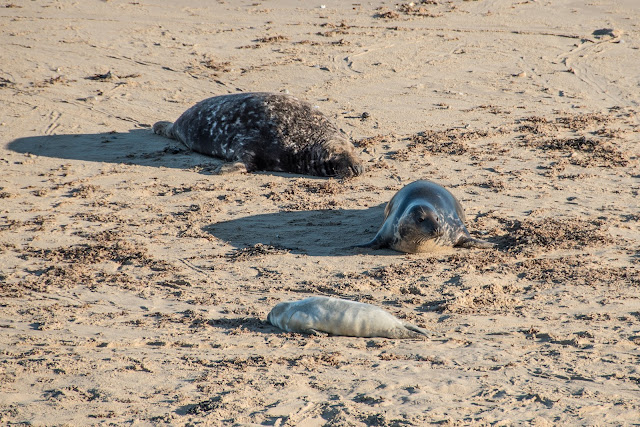The seals at Horsey
A record number of grey seal births at a Norfolk beach shows a "major change" in behaviour as the animals become used to humans, marine experts have said. The 1.5 mile (2.4km) stretch of dunes at Horsey has hosted 1,018 births so far this winter compared to the previous winter when there were 804. (BBC report)
We had been here on a previous visit but decided we would like to see them again. It is a worthwhile trip if you have never seen them.
Mother rushing to protect her pup (and herself probably) from approaching bull.
Keep away from my pup please! Mothers defending their space by putting herself between the bull and her calf.
Mothers and pups, a joy to watch
The big males just kept pestering the females, in or out of the water
Grey seals have grey and brown fur, sometimes with a pattern of blotches; no ears visible; long muzzle; nostrils parallel; larger and darker than common seal, with flat or convex profile to its head (the common seal has a concave profile).
Size:
Average for males 207cm; females 180cm; flippers about 25cm.
Weight:
Males 233kg; Females 155kg.
Origin and Distribution
Grey seals around Great Britain are found mainly along exposed rocky northern coasts. They also occur in the south west and off the east coast, around the Isle of May and the Farne Islands off Northumberland, and along the west coast of Ireland.
Diet
Sand eels and cod are their most important foods, but grey seals are opportunistic feeders and probably take whatever fish are most abundant.
General Ecology
Between the tides they haul themselves out on to rocks, usually on uninhabited offshore islands; though some haul-outs are on secluded mainland beaches. Grey seals are gregarious at these haul-outs, sometimes forming large groups of several hundred, and at Horsey we have seen 2,000 plus animals, especially when they are moulting their fur in the spring. They are not, however, very sociable and keep a distance between one another. About two-thirds of greys seals' time is spent at sea where they hunt and feed. In the autumn grey seals congregate at Horsey beach to breed. The timing of births varies around the coast, beginning in September in West Wales, in October in western Scotland, and as late as November in Horsey.
Pups and Breeding
Grey seal pups weigh about 14 kg at birth and have soft white fur. They remain on land where they suck from their mother for 18-21 days. A female's milk contains up to 60% fat, so pups grow very quickly, gaining about 2kg in weight each day. This weight gain consists mainly of a layer of blubber below their skin, which is vital insulation when they go to sea. During the pupping season, male grey seals also come ashore to mate. The largest males, usually more than 10 years old, compete for a position within groups of breeding females. Occasionally males fight, and may sustain deep scars on their necks as a result.









Comments